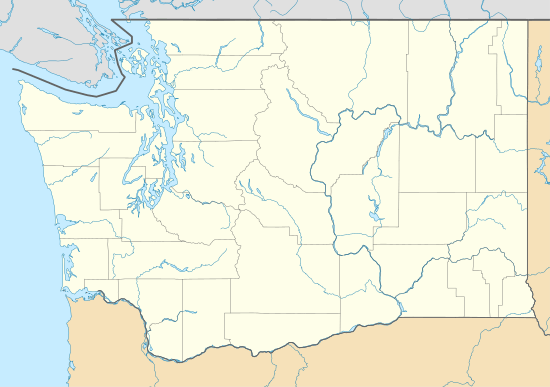Four Lakes, Washington
Four Lakes is an unincorporated community and census-designated place in Spokane County, Washington, United States, just southwest of the city of Spokane, and north of Cheney. As of the 2010 census, its population was 512.[2] Both Interstate 90 and SR 904 run through Four Lakes and the junction of the two is located near the center of town. Four Lakes was founded in 1879 by G.H. Morgan.[4] The community was so named on account of there being four lakes near the original town site.[5] It is speculated the fourth lake, is now a marsh south of Meadow Lake, which was drained by the ditch, blasted through basalt, which Minnie Creek flows through, under SR 904, south of the rodeo grounds.[6]
Four Lakes, Washington | |
|---|---|
 Four Lakes, Washington | |
| Coordinates: 47°33′41″N 117°35′39″W | |
| Country | United States |
| State | Washington |
| County | Spokane |
| Area | |
| • Total | 3.428 sq mi (8.88 km2) |
| • Land | 3.375 sq mi (8.74 km2) |
| • Water | 0.053 sq mi (0.14 km2) |
| Elevation | 2,431 ft (741 m) |
| Population (2010)[2] | |
| • Total | 512 |
| • Density | 150/sq mi (58/km2) |
| Time zone | UTC-8 (Pacific (PST)) |
| • Summer (DST) | UTC-7 (PDT) |
| Area code(s) | 509 |
| GNIS feature ID | 1512225[3] |
Economy
Largely because Four Lakes is a bedroom community for its neighbors such as Cheney and Spokane, there are very few businesses as of 2009. A hair salon, a tavern, a dog grooming business "Heather's Canine Cuts" and a convenience store are among the small handful of businesses that call Four Lakes home. Most of the businesses in Four Lakes have been located there for many years and are firmly rooted. Farms are also plentiful around Four Lakes. The small community has its own post office, water district, and volunteer fire department.
Schools
Four Lakes is located in the Cheney School District. Most Elementary students in Four Lakes attend Betz Elementary, while older students attend either Cheney High School or Cheney Middle School. A very small fraction of high school-age students may attend Three Springs High School in Cheney.
The Battle of Four Lakes
The small town is also home to The Battle of Four Lakes. The granite monument for this battle can be viewed at the corner of 1st st. and Electric Ave. in Four Lakes. The Battle of Four Lakes occurred on September 1, 1858, approximately five miles north of the City of Cheney in the unincorporated town locally known as Four Lakes, Washington. The Battle of Four Lakes was the final battle in a two phase expedition against a confederation of the Coeur d’Alene, Spokane, Palouse and Northern Paiute Indian tribes from the States of Washington and Idaho (the "Confederated Tribes"), which began in August 1856. The two phases of the expedition, together constituted the Yakima War and the Spokane-Coeur d'Alene-Paloos War. Indian attacks on U.S. troops in the greater inland pacific northwest started the expedition as the Yakima War, or the first phase of the expedition. In the second phase, Commander of the Department of the Pacific, General Newman S. Clarke sent a force of soldiers under command of Colonel George Wright to deal with the Confederated Tribes from Washington and Idaho, in what is known as the Spokane-Coeur d'Alene-Paloos War. Col. Wright's troops were well armed with the latest weaponry, and engaged members of the Confederated Tribes under command of Chief Kamiakin just north of present-day Cheney, over a four-day period, and routed the Confederated Tribes in the Battle of Four Lakes, who then sued for peace. The Battle of Four Lakes was the final battle in the expedition. The war was officially ended at a council called by Col. Wright at Latah Creek (southwest of Spokane) on September 23, 1858 which imposed a peace treaty on tribes. Under this treaty most of the tribes were sent to reservations. It was reported that Col. Wright did not lose one soldier in the Battle of Four Lakes. A memorial to the battle was erected on the spot of the battle in 1935 by the Spokane County Pioneer Society. The informational content of the monument is disputed. The monument claims that a force of 700 U.S. Soldiers, defeated a force of 5,000 Indians at the Battle of Four Lakes. Many historical accounts dispute this and suggest that the U.S. Force consisted of 500 Soldiers and 200 muleskinners and the forces of the Confederated Tribes numbered no more than 500. After the Battle of Four Lakes, Chief Kamiakin fled to Canada. The Battle of Four Lakes is also known locally as the Battle of Spokane Plains, because as the battle raged on it spread from the Four Lakes area out to the plains area directly west of the City of Spokane and North East of the City of Cheney.
Climate
This climatic region is typified by large seasonal temperature differences, with warm to hot (and often humid) summers and cold (sometimes severely cold) winters. According to the Köppen Climate Classification system, Four Lakes has a humid continental climate, abbreviated "Dfb" on climate maps.[7]
References
- "US Gazetteer files: 2010, 2000, and 1990". United States Census Bureau. 2011-02-12. Retrieved 2011-04-23.
- "U.S. Census website". United States Census Bureau. Retrieved 2011-05-14.
- "Four Lakes". Geographic Names Information System. United States Geological Survey.
- Majors, Harry M. (1975). Exploring Washington. Van Winkle Publishing Co. p. 111. ISBN 978-0-918664-00-6.
- Meany, Edmond S. Origin of Washington geographic names. Seattle: University of Washington Press. p. 92.
- Personal observation & study by local Rod Hagel
- Climate Summary for Four Lakes, Washington
Heather's Canine Cuts
